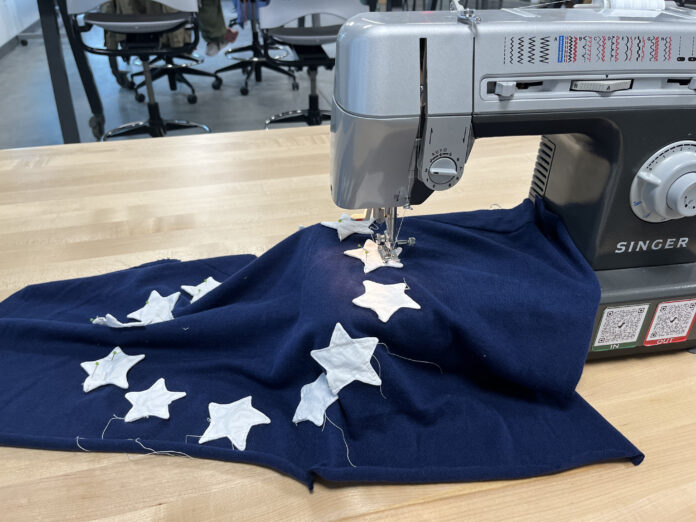At the beginning of April, I was given an assignment in my history class that has reshaped my daily life at Muhlenberg and my identity as a student.
The initial assignment was open-ended; a common project concept in humanities studies.The “unessay” is a prompt that many students in the liberal arts are familiar with. As a final for the class, I was given creative freedom to learn and build a representation of a deeper study into topics discussed in Revolutionary America. I knew almost immediately that I wanted to play to my strengths and sew a flag. It is a quilted version of the original American flag, with 13 stars forming a circle in the field to represent the 13 colonies.
The Muhlenberg Makerspace, located on the ground floor of Fahy Commons, has a simple Singer sewing machine. I showed up at the door the day after I received the assignment with absolutely zero resources, a half-baked vision and a bit of sewing experience (thank you, Grandma Sylvia).
The first person I talked to at the Makerspace was technician Ren Anan. He looked at me a little sideways but without a hint of judgment when I asked to dig through all of the fabrics and clothes that had been donated to the Makerspace. I spent about 20 minutes setting aside anything red, white and blue that I thought would work for my project. Without any context, Ren was intrigued by my endeavors and I excitedly explained to him my concept. He let me know how each piece of fabric had made its way to the space, which ended up being a crucial element to my project: by using all recycled materials, my flag could represent the resourcefulness of women and textile workers during non-importation acts in the 18th century.
The second time I visited the Makerspace, I talked to Eric Schwartz (known to some students as “Agent E,” for reasons that are worth learning about), the other technician who runs the shop. He and Visiting Professor Greg Heller-LaBelle directed me to the sewing machine and its corresponding materials (pins, bobbins, thread, etc). I fully expected them to mansplain the sewing machine to me. As a woman, I have rarely found myself in engineering and innovation settings where I have not experienced condescending tones and unwarranted explanations. I find that this is a universal circumstance for women across all disciplines. So when Ren, Eric and Greg were interested only in my success and not their knowledge, I was genuinely surprised and grateful.
Throughout the three weeks of which the project had consumed my mind, I woke up every day looking forward to the time that I would inevitably spend in the Makerspace. I shifted my typical work rhythms to be in the shop during regular hours when I knew that Ren and Eric would be there for support and conversation as I hunched over the sewing machine and leaped from table to table crafting the stars and stripes. By the end of the first week, I was womansplaining – really, educating – the technicians and other students around about the sewing machine: “You threaded this wrong,” and “Is your bobbin too loose?”
The most difficult part of my flag was the 13 stars. Ren, Eric and Greg were all there to help me through the process. Several prototypes were made, and the most successful was the result of a pattern that Eric and I laser-cut out of cardstock in the Makerspace. I used them to map out the field of the flag and then to sew the stars themselves. After making the pattern, Eric engraved a tag of wood that spelled the letters of my name in elements of the periodic table. He told me that it is a “frequent flier” tag, a special achievement endowed to the most consistently recurring visitors of the Makerspace. Just like his, my frequent flier tag hangs from a zipper pull on my backpack.
I completed my flag blanket, which I have dubbed “The Bretsky Ross Flag” on April 17. I paraded my work around campus like a total dork when I left the Makerspace. To the unrelenting encouragement of Ren and Eric, I have entered the Bretsky Ross Flag into the Makerspace Innovation Challenge under the Decorative category. The winners of the challenge will be announced in the Makerspace at 5 P.M. on Friday, April 26, where they will receive the world’s ugliest 3-D printed trophy named George. I hope I win one.
Right now, Makerspace technicians and students alike do not know what the space’s staffing will look like next year. It is possible that it will be run entirely by students without the presence and essential support of technicians like Ren and Eric. This means that the Provost may decide to eliminate the position as a whole. Without its technicians, the Makerspace would not have had the tremendous impact on my life that is so evident after just three weeks. They are vital to the Makerspace as a resource and Muhlenberg as an institution.
Eric likes to say that students who enter the Makerspace leave the traits that identify them in an educational setting at the door; everyone in the shop is a Creator no matter their major, campus leadership, or social standing. I argue that students who leave the Makerspace inevitably add Creator to their identities, no matter their machine proficiency in the shop.
My story is one of countless students who have been positively impacted by the Makerspace and its technicians. Keeping their presence on campus, though it means that I will probably have to hear the same story about tap dancers from Eric several more times, will be a much bigger win than any prize from the Innovation Challenge.
Kira Bretsky ‘27 is an anthropology major from Santa Monica, CA. She enjoys classic novels, classic rock, and sports photography. The Los Angeles Dodgers’ team photographer Jon Soohoo followers her on Instagram.























